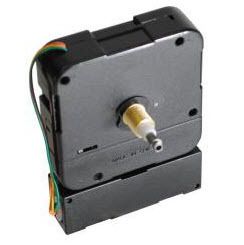About Clock Movements and also Motors
 Clock movements and also motors are the genuine intestines of timepieces. Clock motions as well as motors run mechanically or digitally, identifying at any moment in time the angle subtended by each specific hand. These interesting tools are our focus in this article.
Clock movements and also motors are the genuine intestines of timepieces. Clock motions as well as motors run mechanically or digitally, identifying at any moment in time the angle subtended by each specific hand. These interesting tools are our focus in this article.
Clock electric motors and motions are compatible terms that explain the very same thing, one term maybe favored by nonprofessionals as well as the other by tradespersons. The earliest ones ran purely mechanically, turning a flywheel based on the force coming from a hanging weight or tightly wound spring. A pendulum, in tandem with an escapement, worked as the regulatory authority for the fundamental interval of timing (usually the 2nd).
The modern-day clock motion is digital rather than mechanical. Its heart is a quartz crystal that shakes (resonates) at an exact frequency derived from the crystal geometry. A set of numerical registers partitions the natural frequency into proper timekeeping worths.
Hence the clock motor reveals the moment by turning one spindle (affixed to the second hand) a full turn every min, one more spindle (minute hand) a full turn every hour, and a third pin completely every 12 hours or 1 Day. These hands obviously indicate icons or figures printed on the clock face.
To achieve independent rotation of all the hands, their corresponding spindles (or shafts) have to be concentric. Clocks use gears with the variety of teeth in meticulously calculated proportions to obtain the correct cycles. For this reason, the "seconds" gear activates a tick of the "mins" gear after 60 of its very own ticks, and similarly the "mins" gear activates the "hours" equipment.
Therefore basic timekeeping is accomplished, with the longest cycle being 12 hours. However, there are other structures and time extensions that make use of 24-hour cycles or perhaps longer ones than that.
Within these structures are variants, sometimes subtle, that are integrated into the activity. As an example, one is typically offered the option in between pre-owneds that tick audibly and those that turn with a peaceful, continual move. The tick is a carry-over from the custom of pendulum and escapement motion (not required however frequently sought after), while the move second hand is a typical contemporary choice.
Some clock motors include grand cycles that are month-to-month or regular. To implement them requires a fourth hand that points to the day for a 31-day calendar month or to the day of the week. In these situations the chain of triggering up the cycle pecking order is a lot more complex.
battery operated clock movement
An additional thing to consider is whether the clock will immediately adapt to daylight saving time or otherwise. Some motions, especially those for electronic clocks, can integrate to the atomic clock standard. This conserves having to manually reset the timepiece and also stays clear of a semi-permanent mis-synchronization ought to Congress change the daylight cost savings days.
Some clock motions can presenting weather info instead of, or in addition to, revealing the time. Typical information are temperature level, barometric pressure, as well as humidity, which are obtained from sensing units rather than calculated inning accordance with a cycle. However, weather activities revealing tidal information (i.e., trend degree) track both lunar as well as solar cycles, and also they additionally incorporate impacts based on local conditions.
Revealing weather condition information needs a minimum of an extra hand or hands, and it may additionally need specifically adjusted dials. To earn tidal screens accurate, one also needs to calibrate the motor itself.
We have actually taken a look at the major functions of electric motors; currently we want to review the additional or second attributes that they provide. These are either developed into the tool itself or are provided as attachments with their very own switches.
First of all, common clock activities equip enough torque to turn little- or medium-sized hands a cycle. (This indicates that the length of the minute hand, from pivot indicate tip, goes to most 6 inches.) Exactly what about large clocks?
As clock hands grow they additionally get heavier. Requirement movements are no longer solid sufficient to turn them. In these instances, the clockmaker must seek a high torque model with the very same collection of attributes as the conventional version.
We now commit a word or more concerning power. Mechanical clocks drove the functions with weights or springtimes, and these obviously had to be reset to their optimal potential power states regularly. Nowadays electrical energy is the owning force, calling for power cords linkeded into wall surface outlets or batteries (e.g., C or AA cells).
Batteries need to be replaced from time to time, and electricity discontinues to move when the power heads out. This is hardly ever a critical concern, though preserving accurate time is necessary in some conditions. A great service is to outfit the clock with both a power cable and a battery.
This way, one type of electrical energy could take over when the various other is stopping working. A variant on this style is the uninterruptible power supply (UPS). Another suggestion, especially beneficial for outdoors, is to make use of solar clocks the rechargeable batteries for which get juiced via solar energy.
To have Westminster (or other formed) chimes play in the house, think about using chiming clock activities. To have the uniqueness of oscillating pendulums attached to your clocks, order this attribute (as most motions provide it). Which is all there is to understand about clock movements as well as motors.